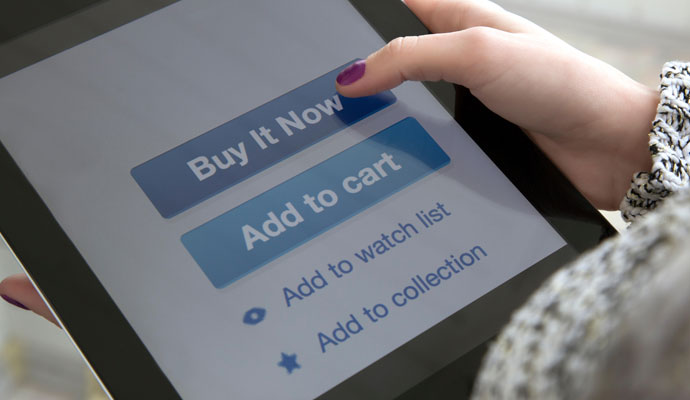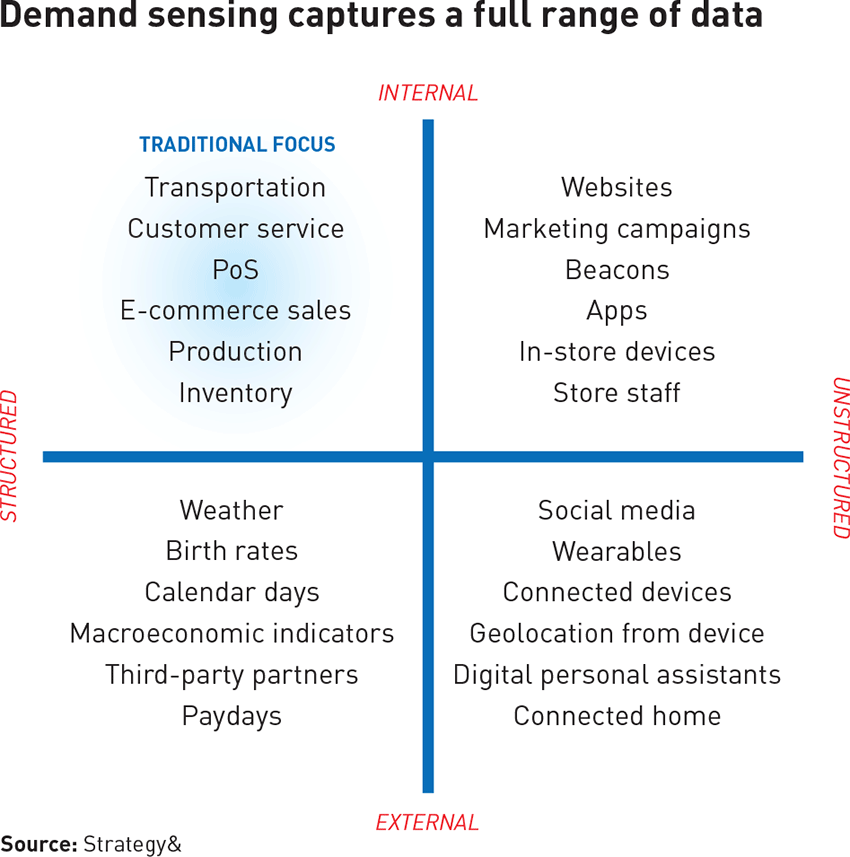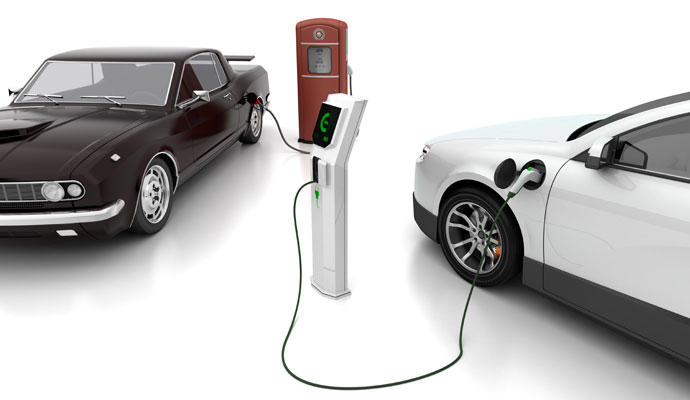The Magic of Predicting Demand from Data
Demand sensing is a key element of a real-time, connected supply chain ecosystem and can kick-start digital transformation.
Sometimes the speed of Amazon’s delivery is bewildering. No matter how obscure your order, the retailer frequently promises same-day delivery. How is that possible? Is it that your neighborhood is full of fly-fishing buffs, or whatever your niche interest may be? Probably not. Instead, it is likely that the company has already shipped the product to your nearest warehouse because it thought that you might order it.
Magical as this might sound, it is the application of a technology known as demand sensing. Demand sensing uses new digital technologies to analyze data sources — made up of a company’s own historical data and other real-time signals — in order to determine where and when potential consumers will buy a product, and in what quantity, well before they actually do.
This allows companies to get closer to the consumer by creating a better understanding of consumer behavior and its implications for the supply chain, at a time when almost all businesses face unprecedented volatility. That is particularly important when one considers the changing consumer expectations for services such as instant order fulfillment.
Demand sensing allows companies to get closer to the consumer by creating a better understanding of consumer behavior and its implications for the supply chain.
The result is that companies get products to consumers faster, deliver consistently excellent service, increase sales, and ensure that few, if any, unsold products are returned to suppliers. Demand sensing also enables a real-time, connected supply chain ecosystem, reducing errors in forecasting by up to 45 percent, in our experience, resulting in greater efficiency, better reliability, and increased consumer satisfaction.
Why now? Demand sensing’s time has come thanks to the availability of new data sources impacting demand, increased computing power, and artificial intelligence. Companies are using this access to new data and building up demand sensing capabilities to better understand consumer behavior and orchestrate their supply chains accordingly.
The higher a company’s sales volumes are and the closer the company is to its consumers, the greater the relevance for demand sensing. This is one reason that retail and fast-moving consumer goods companies have been early adopters. However, demand sensing is becoming increasingly important for other sectors as well, such as automotive, industrial products, energy, and pharmaceuticals. The automotive industry, for example, can now gain really useful information about consumer preferences from the various “configurator” apps that allow individuals to choose the specifications of their car.
Even in low-volume businesses such as aerospace, demand sensing is becoming more relevant because of its applicability to the provision of repair services and spare parts. Aircraft engine manufacturers routinely have live streams of data coming from their products during flight, for example, allowing the manufacturers to monitor conditions in real time, carry out tune-ups, and set spare-part inventory.
When it comes to adoption of demand sensing so far, companies divide into two camps: those that tend to build their solutions in-house, using open source algorithms that are continuously improved by a large community, and those that use a range of cloud-based software-as-a-service (SaaS) third-party solutions available from excellent data-mining and supply chain players.
Vattenfall, a Swedish energy group, and Orsted, a Danish company formerly known as Dong Energy, have developed an in-house solution in the form of a wind power forecasting system that takes inputs from various sources, including weather data and information from sensors, for an offshore wind farm that the companies operate at Horns Rev, in the North Sea off Denmark. These sources are fed into a neural network (a type of artificial intelligence) to identify the most influential parameters, which are then integrated into the prediction system.
One example of a company calling on an outsourced solution is Procter & Gamble, which has used demand sensing for several years. It draws on information such as point-of-sale (PoS) data, channel inventory, warehouse stock movements, data from distributors, and forecasts from retailers, all of which is fed daily into an analytics model .
German retailer Otto has implemented a demand sensing system that creates daily forecasts for every item based on hundreds of variables. The priority has been to distill massive data volumes into real-time decision making, and the system has resulted in a 40 percent increase in forecast accuracy per item and a 20 percent reduction in overstock.
Almost every company has access to the data it needs to make better forecasts — and many also have access to the computing power and machine-learning algorithms necessary to leverage that data. Those that don’t at least have access to companies that can provide such expertise. One trend we think will become evident is more data networks emerging between unrelated companies, allowing businesses access to data they would not otherwise have been able to see. For example, if airports began sharing data about consumer flows through terminals, this data might feed into the demand sensing models of, for example, cab firms or aircraft manufacturers.
But the bottom line is that all that’s required to make demand sensing work is the willingness to spend some time looking for potential demand signals, putting them into an analytics engine, and integrating the results into supply chain planning and execution.
Four broad areas of data come into play here, which are laid out in the diagram below. They are (1) structured internal data, such as that from a PoS system, e-commerce sales, and consumer service; (2) unstructured internal data, for example, from marketing campaigns, in-store devices, and apps; (3) structured external data, which includes macroeconomic indicators, weather patterns, and even birth rates; and (4) unstructured external data, such as information from connected devices, digital personal assistants, and social media.
Often, algorithms will be used to perform social media “sentiment” analysis of this data, in an attempt to ascertain whether posts are positive, negative, or neutral — and in turn help to provide insights about consumer perception.
Certainly, not all the data in this grid applies in the same way to every sector, region, and stage in the product life cycle or consumer type. Its influence might change over time or apply differently in different contexts. For instance, a global retailer sees increased foot traffic in its European stores when the weather is rainy, because in good weather people like to be outside. In regions like South America, however, foot traffic increases in sunny weather because stores and malls are usually air conditioned.
This underlines the fact that without understanding context, you cannot properly apply the data. But once you understand the context, that understanding serves as a key foundation for other activities as well, such as the design and implementation of new data-driven business models.
Demand sensing should be an integral part of a real-time, connected supply chain. It is not a replacement for demand planning, which has hitherto been used for supply chains — that is, creating forecasts using internal and structured data such as sales history. But demand sensing does enhance demand planning and makes supply chains far more responsive to demand.
Specifically, demand sensing enables automation of short-term planning, freeing up supply chain experts for more mid- and long-term strategic tasks and enabling them to focus on alerts and exceptions (such as unexpectedly running out of stock). Demand sensing delivers the greatest value if its results are used in processes such as sourcing, smart replenishment, dynamic warehousing, and real-time production scheduling.
The rewards for implementing demand sensing are potentially enormous. As noted above, our cross-industry experience shows that it can reduce forecast error by 35 to 45 percent, leading to improved forecast accuracy.
This has three impacts: First, on the top line, as fewer stock-outs lead to 5 to 10 percent higher sales. Second, on the bottom line, because less manual planning leads to 5 to 10 percent lower operational costs. And third, on tied-up capital, because having lower safety stocks reduces overall throughput time by 10 to 20 percent.
Another reward is that demand sensing can be a starting point for the digital transformation of the whole business, because it is comparatively easy and quick to implement, and can produce rapid, tangible benefits. In general, companies face both external “pull” movement toward digital transformation (such as more demanding consumer expectations for things such as instant order fulfillment) and technological “push” movement (universal connectivity and availability of real-time data). Demand sensing is well-placed to kick-start digital transformation because it serves both kinds of movement.
However, the quantitative benefits are not the only reason that implementing demand sensing can be a good starting point for a wider digital transformation. It also generates early buy-in across the organization because it proves the value of new tools fast and typically delivers rapid, tangible benefits. It can boost what we might call “internal pride,” opening the way for further digital initiatives along the entire supply chain, such as integrated planning and execution, supply chain transparency, or smart manufacturing — and then more broadly for new data-driven business models.
How do you get started? The first step for any organization is to understand what data is available and which data points have a potential effect on consumer demand. Once a business has identified these, we recommend starting small and adopting an agile approach. Find one area of the business in which you have data for the potential demand influencing factors going back at least two years. It could be one product family, such as sodas, or a section of the business, maybe retail outlets in Belgium. Test your process to discover which data sources have the most predictive value and over which time horizon, then remove those that have little impact.
Use the first year’s data to build the engine by applying demand sensing algorithms and machine learning. Use the second year’s data to fine-tune it by pretending that you don’t know what happened that year. How does the prediction compare to what really took place? The more you learn, the more accurate the predictions get. If you have more years and more sources of data available, even better, because it will allow you to feed the engine more precisely.
Starting with a small area of the business will allow you to achieve quick results, reduce the complexity of regional and market-specific differences, and leverage lessons from the first iterations.
It is also essential to remain flexible and apply an iterative process given that we are in a fast-changing environment. Some data might become less useful over time. Other new and as yet unknown sources of data will emerge that can be added as necessary.
Nevertheless, some obstacles prevent many companies from moving to demand sensing technology. One is that company leaders are simply unaware of the value that it can provide. For such businesses it is worth, at the very least, running the kind of prototype described above to see what value it can provide using available data.
Another obstacle is that many companies are wary of trusting automated systems. This makes sense. After all, the company has hired, trained, and developed the best talent it can find. But humans are limited in the extent to which they can process vast amounts of data and deal with the factors that must be considered when planning demand for today’s supply chain. Such complexity is something at which machines excel.
A side-by-side test is a good way to develop trust. Compare the results of your analytics model with your human forecasters’ results in an area where historical data is available.
In any case, your system can always be overruled by your human planners. You can compare the system’s predictions again later to see which were more accurate. Crucially, the automated system will learn from its experience and human input, tweaking the algorithm and becoming more accurate over time.
Over the next few years, any company that wishes to maintain or expand its current market position will need to embrace a connected, real-time supply chain enabled through demand sensing. The pace of change is too fast and the number of influencing factors too great for traditional models, which rely on the statistical analysis of historical data, to remain serviceable.
The benefits we outline here are just the start. By preparing the ground for a wider digital transformation and enabling a truly connected end-to-end supply chain, demand sensing not only delivers substantial benefits in sourcing, manufacturing, warehousing, and distribution, but also lays the foundation for new data-driven business models with increased consumer interaction.
If there is much to gain by embracing demand sensing, there is even more to lose by not doing so. As demand sensing makes its way into sectors that have not thus far exploited it, the early adopters in those industries will improve their market position quickly. Those who don’t seize the opportunities will fall behind and may find themselves unable to catch up.
Author profiles:
- Philipp Berttram is a principal with PwC Strategy& Germany. He is a leading practitioner in supply chain management and digital operations and leads the firm’s digital supply chain team in Germany.
- Judith Schneider is a manager with PwC Strategy& Germany. She specializes in digital supply chain management and operations and is a core team member of the PwC Strategy& Industry 4.0/digital operations team in Europe, the Middle East, and Africa (EMEA).
- Marc Münch is a senior associate with PwC Strategy& Germany. He focuses on digital operations and supply chain management and is a core team member of the PwC Strategy& Industry 4.0/digital operations team in EMEA.
- Stefan Schrauf, managing director with PwC Strategy& Germany, also contributed to this article.





